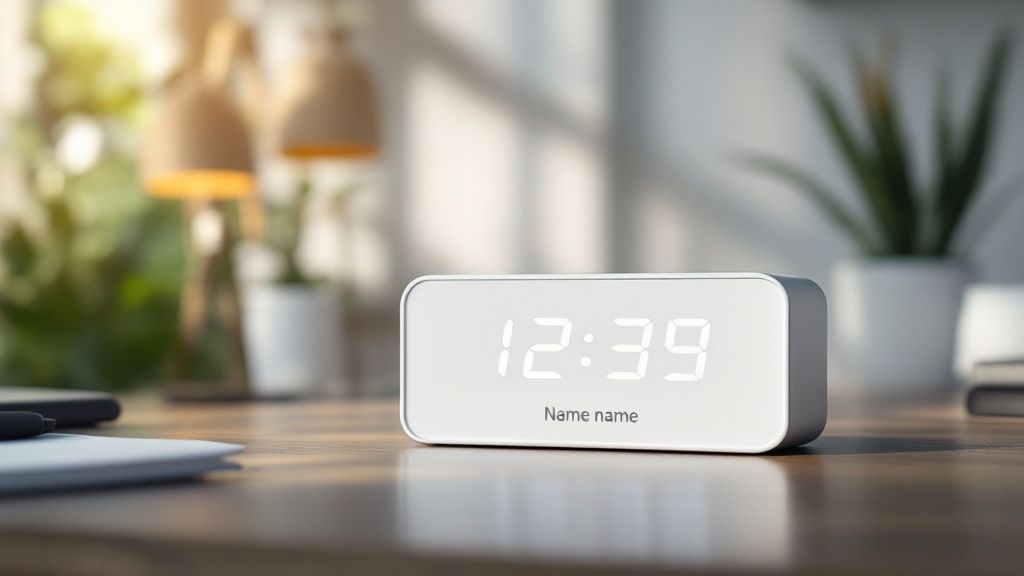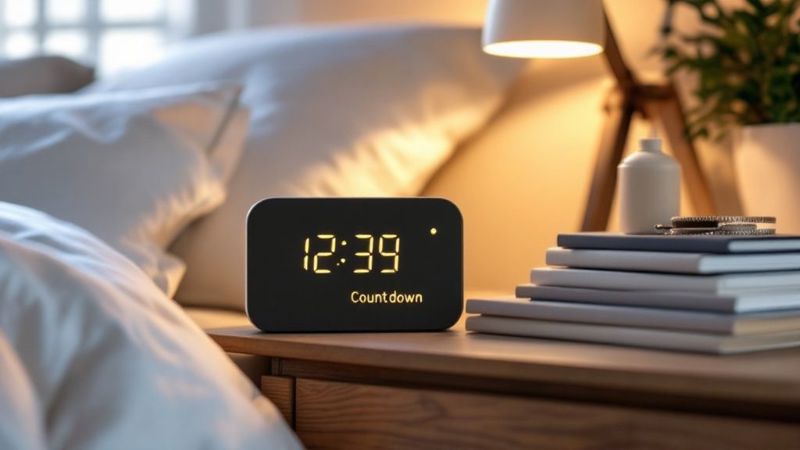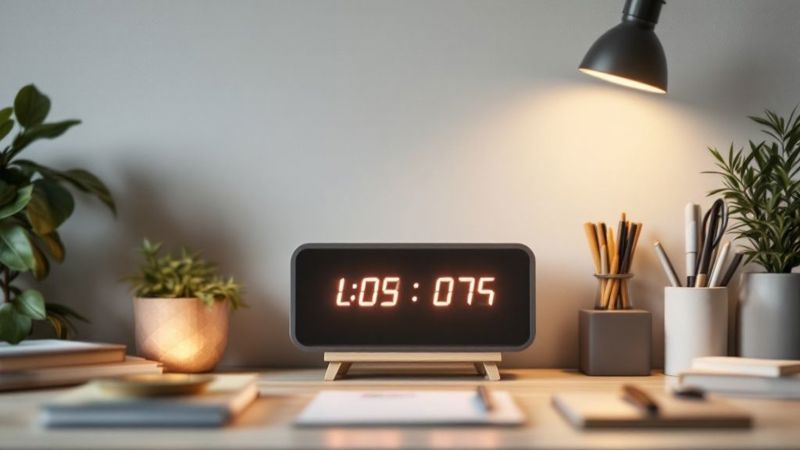Understanding the Psychology of Time-Driven Marketing

Countdown clocks do more than just display time - they tap into core human psychology to shape buying decisions. These visual tools connect with our basic desires to get the best value and avoid missing out on opportunities. Understanding the psychological impact of time-based marketing helps businesses use countdown clocks more effectively.
The Power of Scarcity and Urgency
The scarcity principle is a key factor at work here - when people think something is in limited supply or won't last long, they value it more highly. This connects directly to the fear of missing out (FOMO). A countdown clock makes this scarcity visible and real by showing exactly how much time remains. Together, these create strong motivation to take action.
Time-based marketing also builds on our response to urgency. Watching time tick away creates pressure to decide quickly rather than delay. This works especially well for special deals and limited-time offers. The visual countdown makes the deadline feel more concrete and meaningful. Want to learn more about countdown psychology? Check out this resource: Timer Psychology Guide. You may also like: How to master personalized email marketing.
Anticipation and the Endowment Effect
Countdown clocks generate anticipation by visually tracking time until an event or offer expires. This builds excitement and momentum that makes people more eager to participate or purchase.
These timers can also trigger the endowment effect - our tendency to place higher value on things we feel we already own. By presenting an offer as something customers could have if they act in time, countdowns make the potential loss feel more real and motivating.
Implementing Psychological Insights
Smart marketers use these psychological principles to design countdown campaigns that drive results. Key factors to consider:
- Timer Placement: Strategic positioning on the page affects how much attention and impact the timer receives
- Clear Communication: The words used with the timer should emphasize limited time and availability
- Personal Touch: Customizing the countdown experience for each visitor increases its effectiveness. This could include showing personalized messages alongside the timer.
When used thoughtfully, countdown clocks become powerful tools for boosting engagement and sales rather than just decorative elements.
Crafting High-Converting Timer Experiences
A personalized countdown clock does more than just display time - it motivates action and drives real results. When implemented thoughtfully, these timers create genuine urgency that inspires customers to take the next step. Let's explore how to maximize their effectiveness.

Strategic Timer Placement and Messaging
The location of your countdown timer can make or break its impact. While placing it "above the fold" often works well, the key is aligning it with your specific page layout and customer journey. For example, positioning the timer next to a key call-to-action button can boost click rates significantly. The message accompanying your timer should clearly communicate both the value of your offer and its time-sensitive nature.
Design Elements that Drive Conversions
Visual appeal matters when it comes to timer effectiveness. Your countdown clock should match your brand's look and feel through:
- Consistent brand colors and fonts
- Thoughtful logo integration
- Appropriate size and animations
- Clean, uncluttered design
The goal is to make the timer noticeable without overwhelming the rest of your content.
Personalization and A/B Testing
The real power of countdown timers comes from personalization. By tailoring the experience to different audience segments, you can dramatically increase conversions. Consider:
- Offering special discounts based on purchase history
- Adjusting messaging for different customer groups
- Testing various timer styles and placements
- Tracking results to optimize performance
Regular A/B testing helps identify what resonates most with your specific audience. Discover more insights about countdown timers to keep improving your results.
Rather than using a one-size-fits-all approach, focus on creating timer experiences that feel personal and relevant to each viewer. This targeted strategy typically delivers much better conversion rates than generic solutions.
Mastering Platform-Specific Implementation

Adding a customized countdown clock to your website doesn't have to be complicated. Whether you use WordPress or Shopify, there are simple ways to add this powerful feature without extensive coding knowledge.
WordPress and Countdown Integration
WordPress makes it easy to add countdown timers through plugins. Here's how to get started:
- Choose Your Plugin: Pick a countdown timer plugin with good reviews and regular updates. Popular options typically have thousands of active installations.
- Set Up Your Design: Adjust colors, fonts, and styling to match your website's look and feel.
- Pick Strategic Locations: Place timers where they'll catch attention - try header banners, landing pages, or near your call-to-action buttons.
Effortless Shopify Integration
Shopify store owners can quickly add countdown clocks using the app store:
- Simple Setup: Apps like Elfsight let you add timers without touching code
- Smart Placement: Add timers to product pages and shopping carts
- Shipping Deadlines: Show countdowns for delivery cutoff times
Making It Your Own
The key to success is making your countdown clock feel like a natural part of your site. One popular tool, TickCounter, is used by over 1.9 million websites because it's both effective and easy to customize.
Solving Common Problems
Here's how to handle typical countdown clock issues:
- Speed Matters: Make sure your timer loads quickly, especially on mobile devices
- Mobile-Friendly: Test your timer on different screen sizes
- Stay Current: Keep your plugins and apps up to date to avoid glitches
By following these straightforward steps, you can add an effective countdown clock that works smoothly across your chosen platform while boosting engagement with your audience.
Optimizing Mobile Timer Experiences

With most people now browsing on phones and tablets, getting countdown timers right on mobile devices is essential for marketing success. Let's explore how to create smooth, effective timer experiences that work well on smaller screens.
Visibility and Responsiveness
Mobile screens don't give you much space to work with. That's why timer visibility needs to be your top priority - place your countdown clock where users can easily see it without it getting in the way of other content. Responsive design is equally important. Your timer should automatically adjust to fit different screen sizes and orientations while staying clear and functional. This often means dynamically changing the timer's size, text, and position based on the device.
Enhancing User Interaction
Mobile devices open up new ways to engage users with countdown timers. Push notifications can remind people about upcoming deadlines and bring them back to your site. Adding interactive elements like tappable timers that reveal more offer details can boost engagement. Some apps have found success by including personalized images in their notifications to catch users' attention. For more ideas, check out: How to increase click rate in email marketing with personalized images.
Addressing Mobile Challenges
Mobile optimization comes with specific hurdles to overcome. Load time is crucial - nobody wants to wait for a slow timer to appear. Focus on clean code and optimized images to keep things snappy. You'll also want to maintain cross-device consistency so users get the same quality experience whether they're on phone or desktop. The demand for mobile countdown timers is clear - take the Countdown Widget app on Google Play, which has racked up 5 million downloads and holds a 3.8-star rating from 118,000 reviews. Users love its personalization options, right down to heartbeat-level countdowns. See the full stats here: Countdown Widget on Google Play. Keep these factors in mind to create countdown timers that work beautifully on any mobile device.
Building Viral Social Campaigns With Timers
Countdown clocks can help you stand out on social media and build excitement around your brand. When used well, customized timers generate organic sharing and get people talking about your upcoming events, launches, and offers.
Creating Shareable Countdown Moments
Social media users love sharing content that builds anticipation. A personalized countdown gives them exactly that - a dynamic element that shows something exciting is coming soon. Whether you're launching a new product, running a flash sale, or hosting an online event, timers create natural opportunities for sharing. Let your audience participate by encouraging them to share photos and videos related to the countdown. This turns them from observers into active promoters.
Cross-Platform Promotion and Audience Participation
To maximize reach, share your countdown across all your social channels. Consider running contests where sharing the countdown enters people to win prizes. You can also invite followers to create their own personalized countdowns tied to your campaign. This builds community and gets more people invested in the outcome. For more engagement tips, check out How to boost event registration with personalized emails.
Using Timers to Build Excitement
Countdown timers tap into powerful psychology that makes them perfect for social media. The visible clock creates urgency and FOMO (fear of missing out), motivating people to take action before time runs out. This works especially well for limited offers and exclusive content reveals. The visual appeal also helps them stand out in busy social feeds. According to Countingdownto.com, their timers get 200-500 shares per day on social media, showing how countdowns naturally inspire sharing and discussion.
Examples of Successful Timer Campaigns
Many brands have used countdown clocks to create buzz on social media. Product launches often use countdowns paired with teaser content leading up to the big reveal. Contest countdowns also work well - offering prizes for sharing helps the campaign spread organically through participants' networks. Study what works for others and adapt those techniques for your unique audience and goals.
Making Countdown Timers More Personal and Effective
Countdown timers have evolved beyond basic displays into powerful tools for connecting with audiences. Modern timers can adapt to individual users and create meaningful interactions that motivate action.
Smart Timers Powered by AI
AI technology brings new capabilities to countdown timers by analyzing user data. These smart timers can study browsing patterns, purchase history, and other behaviors to show personalized messages and offers. For example, a timer might highlight products matching a visitor's interests while counting down to a sale end. AI-enhanced timers increase engagement by making each countdown uniquely relevant to the viewer.
Live Updates and Adaptive Content
Modern countdown timers feature dynamic content that adjusts based on important factors:
- User location and time zone
- Current inventory levels
- Pricing changes
- Ongoing promotions
For instance, an airline could display a countdown to a flight deal where the price updates in real-time based on seat availability. This keeps the content fresh and engaging.
Working Together with Marketing Tools
Today's countdown timers connect smoothly with other key marketing systems. They sync with email platforms, customer databases, and social media to create consistent experiences. A timer in an email campaign can link to a matching countdown on a landing page, reinforcing the urgency. This coordination across channels helps drive more conversions.
What's Next for Countdown Timers
The technology behind countdown timers continues to improve. We'll see more advanced AI features, smarter content updates, and better integration with marketing tools. The goal is creating interactive timers that guide customers naturally through their journey while driving real results.
Ready to boost your marketing with smart countdown timers? Get started with OKZest to create engaging, personalized experiences today.